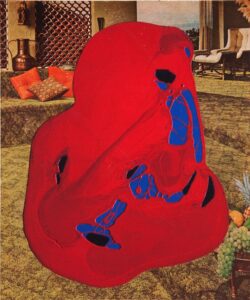Jim Richard
Jim Richard is best known for his paintings of modernist works of art situated in richly decorated and ominously claustrophobic home interiors.

Courtesy of Jim Richard
Dominant Red. Richard, Jim (artist)
Tim Richard is best known for his paintings of modernist works of art situated in richly decorated and ominously claustrophobic home interiors. As far back as 1969 he created a series of works that positioned male cartoon figures seen on commercial first aid kits in suburban patios and yards. These paintings led in 1979 to Richard’s first paintings of suburban home interiors decorated with modern sculptures. Through the following decades, Richard explored magazines and advertisements for examples of wallpaper, furniture, and upholstery, fusing these elements into invented residential spaces. In his paintings and collages, decorative objects compete with loud examples of home decor.
Richard does not eschew “tackiness” in his interiors. Rather, his work straddles the line between celebrating and critiquing kitsch and rampant consumer culture. In 2010, Richard’s paintings underwent a significant change. After typically tracing a black outline around his forms (in a graphic style inspired by New Orleans painter Robert Gordy), Richard eliminated the black lines, allowing his colors to abut each other. The result heightens the effects of his colors, allowing them to come forward in an almost abstract manner.
Richard was born in 1943 in Port Arthur, Texas. He obtained a bachelors of science degree in commercial art from Lamar State College of Technology in Beaumont, Texas, in 1965. Breaking free of the notion that he had to work as a commercial illustrator to survive, Richard first experimented with painting in an abstract expressionist style. He pursued his MFA degree at the University of Colorado in Boulder, graduating in 1968. During the late 1960s he gravitated toward a pop-art sensibility, particularly admiring the playful irreverence of the Chicago Hairy Who artists and the California Funk movement (having studied under visiting professor William Wiley). Around this time Richard began collecting clippings of home interiors and backyards, saving materials that would later become sources of artistic inspiration.
Richard taught at Spring Hill College in Mobile, Alabama, from 1968 to 1972, and was an associate professor at Nicholls State University in Thibodaux, Louisiana, from 1972 to 1975. The enticing, graphic nature of his paintings, coupled with their exploration of consumer culture, has led Richard to be included in more iterations of the juried New Orleans Triennial (until 2008 the oldest and longest running survey of contemporary art in the United States) than any other artist in its history. As a professor of painting at the University of New Orleans (UNO) for the past thirty-six years, Richard has played a pivotal role in maintaining the strength of the fine arts department at UNO, which for several decades has been a fount of artistic activity in New Orleans. Through UNO Richard has influenced a generation of students, including painters Wayne Gonzales and Peter Halley, sculptor Lucky DeBellevue, and multimedia artist Megan Whitmarsh.
